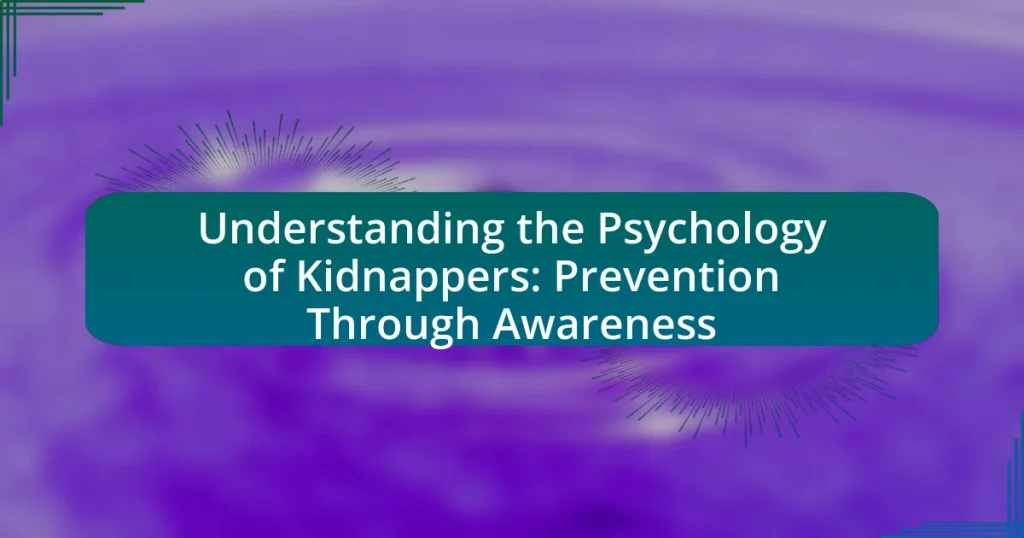The article focuses on understanding the psychology of kidnappers, emphasizing the complex motivations behind their actions, such as financial gain, power, and control. It explores the psychological traits common among kidnappers, including antisocial personality characteristics and the influence of past trauma. Additionally, the article discusses how social environments and community dynamics can impact kidnapping behavior, highlighting the importance of awareness and education in prevention efforts. Key strategies for individuals and communities to enhance safety and recognize potential threats are also outlined, along with the role of technology and organizations dedicated to kidnapping prevention.

What is the Psychology of Kidnappers?
The psychology of kidnappers often involves a complex interplay of motivations, including financial gain, power, and control. Many kidnappers exhibit antisocial personality traits, characterized by a lack of empathy and remorse, which can lead to violent behavior. Research indicates that some kidnappers may also have a history of trauma or abuse, influencing their criminal behavior. For instance, a study published in the Journal of Criminal Psychology highlights that many offenders engage in kidnapping as a means to exert dominance over their victims, reflecting deeper psychological issues such as insecurity or a need for validation. Understanding these psychological factors is crucial for developing effective prevention strategies and raising awareness about the risks associated with kidnapping.
How do kidnappers justify their actions?
Kidnappers often justify their actions through a distorted sense of necessity or entitlement, believing that their motives, such as financial gain or ideological beliefs, validate their criminal behavior. For instance, some kidnappers rationalize their actions by claiming they are providing for their families or fighting against perceived injustices, which they believe legitimizes the harm they inflict on others. This psychological justification can be reinforced by social or cultural factors that normalize violence or coercion in certain contexts, as seen in various criminal organizations where such acts are viewed as acceptable means to an end.
What psychological factors contribute to a kidnapper’s mindset?
Psychological factors contributing to a kidnapper’s mindset include a combination of personality disorders, social influences, and situational triggers. Many kidnappers exhibit traits associated with antisocial personality disorder, characterized by a lack of empathy, impulsivity, and manipulative behavior. Research indicates that environmental factors, such as exposure to violence or trauma during childhood, can also shape these individuals’ propensity for criminal behavior. Additionally, the desire for power and control often drives kidnappers, as they seek to dominate their victims psychologically and physically. Studies have shown that these psychological elements are frequently intertwined, creating a complex framework that informs the motivations behind kidnapping.
How does social environment influence kidnapping behavior?
Social environment significantly influences kidnapping behavior by shaping the motivations and opportunities for such acts. Factors such as socioeconomic status, community cohesion, and cultural norms can either deter or encourage individuals to engage in kidnapping. For instance, areas with high poverty rates may see increased kidnapping incidents as individuals may resort to crime out of desperation. Additionally, communities with weak social ties may lack the collective efficacy to prevent such crimes, making it easier for kidnappers to operate. Research indicates that environments characterized by social disorganization often correlate with higher crime rates, including kidnapping, as seen in studies conducted by the National Institute of Justice, which highlight the relationship between community structure and crime prevalence.
What are the common traits of kidnappers?
Common traits of kidnappers include manipulative behavior, a lack of empathy, and a tendency to plan meticulously. These individuals often exhibit a high degree of control over their victims, using psychological tactics to instill fear and compliance. Research indicates that many kidnappers have a history of antisocial behavior and may struggle with impulse control, which can lead to violent actions. Additionally, studies show that kidnappers often target vulnerable individuals, demonstrating a calculated approach to selecting victims based on perceived weaknesses.
How do personality disorders manifest in kidnappers?
Personality disorders in kidnappers often manifest through traits such as impulsivity, lack of empathy, and manipulative behavior. These characteristics can lead to criminal actions, including kidnapping, as individuals with certain personality disorders, like antisocial personality disorder, may disregard societal norms and the rights of others. Research indicates that such individuals often exhibit a pattern of deceitfulness and aggression, which can facilitate their ability to plan and execute kidnappings. For instance, a study published in the Journal of Criminal Psychology highlights that many kidnappers display traits associated with narcissism and psychopathy, contributing to their capacity for violence and lack of remorse.
What role does past trauma play in the development of a kidnapper?
Past trauma significantly contributes to the development of a kidnapper by influencing their psychological state and behavior patterns. Research indicates that individuals who experience severe trauma, such as abuse or neglect during childhood, may develop maladaptive coping mechanisms, including aggression and a distorted sense of control. For instance, a study published in the Journal of Interpersonal Violence found that childhood trauma is linked to increased likelihood of engaging in violent criminal behavior, including kidnapping. This correlation suggests that unresolved trauma can manifest in harmful ways, leading individuals to perpetrate acts of violence as a means of exerting power or addressing their own emotional pain.
Why is understanding the psychology of kidnappers important?
Understanding the psychology of kidnappers is important because it aids in developing effective prevention strategies and response protocols. By analyzing the motivations, behaviors, and patterns of kidnappers, law enforcement and security professionals can better anticipate potential threats and implement measures to protect individuals. Research indicates that understanding these psychological factors can lead to a reduction in kidnapping incidents; for instance, studies have shown that profiling kidnappers based on their psychological traits can enhance negotiation tactics and improve victim recovery rates.
How can this understanding aid in prevention efforts?
Understanding the psychology of kidnappers can significantly enhance prevention efforts by informing targeted strategies that address the motivations and behaviors of potential offenders. By recognizing factors such as desperation, financial gain, or psychological issues that drive individuals to commit kidnapping, law enforcement and community organizations can develop tailored educational programs and intervention strategies. For instance, studies indicate that awareness campaigns focusing on the warning signs of predatory behavior can reduce the likelihood of abductions, as they empower individuals to recognize and respond to threats effectively. Additionally, understanding these psychological factors allows for the implementation of community support systems that address underlying issues, such as poverty or mental health, thereby reducing the risk of kidnapping incidents.
What implications does this knowledge have for law enforcement?
Understanding the psychology of kidnappers has significant implications for law enforcement, as it enhances their ability to prevent and respond to kidnapping incidents effectively. By comprehending the motivations, behaviors, and psychological profiles of kidnappers, law enforcement can develop targeted strategies for prevention, such as community awareness programs and profiling techniques. Research indicates that understanding these psychological factors can lead to more effective interrogation methods and negotiation tactics, ultimately increasing the chances of a successful resolution in kidnapping cases. For instance, studies have shown that recognizing the emotional triggers of kidnappers can inform law enforcement’s approach during crisis situations, thereby improving outcomes for victims.

How can awareness prevent kidnapping?
Awareness can prevent kidnapping by enabling individuals to recognize potential threats and respond appropriately. When people are educated about common kidnapping tactics, such as grooming or surveillance, they are more likely to identify suspicious behavior and take preventive measures. For instance, studies show that communities with awareness programs report a decrease in abduction attempts, as individuals are more vigilant and proactive in protecting themselves and others. By fostering a culture of awareness, individuals can create safer environments that deter potential kidnappers.
What strategies can individuals use to stay safe?
Individuals can stay safe by being aware of their surroundings and avoiding risky situations. Awareness includes recognizing potential threats, such as unfamiliar individuals or environments that feel unsafe. For instance, studies show that 70% of kidnappings occur in familiar locations, emphasizing the need for vigilance even in seemingly safe areas. Additionally, individuals should establish a safety plan, which may involve sharing their location with trusted friends or family and having a designated safe word for emergencies. Implementing these strategies can significantly reduce the risk of becoming a target for kidnappers.
How can situational awareness reduce the risk of kidnapping?
Situational awareness can significantly reduce the risk of kidnapping by enabling individuals to recognize potential threats and avoid dangerous situations. By being aware of their surroundings, individuals can identify suspicious behavior, unusual activities, or individuals who may pose a risk, allowing them to take preventive actions. Research indicates that heightened situational awareness leads to better decision-making in potentially hazardous environments, as individuals are more likely to notice warning signs and react appropriately. For instance, a study published in the Journal of Criminal Justice found that individuals who practiced situational awareness were less likely to become victims of crime, including kidnapping, due to their ability to detect and respond to threats effectively.
What role does community involvement play in prevention?
Community involvement plays a crucial role in prevention by fostering a collective awareness and proactive approach to safety. Engaged communities can effectively share information, identify potential risks, and implement preventive measures, which significantly reduces the likelihood of criminal activities, including kidnapping. Research indicates that neighborhoods with active community programs and strong social ties experience lower crime rates, as residents are more vigilant and responsive to suspicious activities. For instance, a study published in the Journal of Criminal Justice found that community policing initiatives, which rely on community involvement, led to a 20% decrease in crime rates in participating areas. This demonstrates that when communities collaborate and communicate, they enhance their ability to prevent crime and protect vulnerable individuals.
How can education help in preventing kidnappings?
Education can help in preventing kidnappings by equipping individuals with knowledge about safety practices and awareness of potential threats. Programs that teach children and adults about recognizing suspicious behavior, understanding personal boundaries, and employing safety strategies can significantly reduce vulnerability to abduction. For instance, studies show that children who receive training on how to respond to strangers are less likely to become victims of kidnapping. Additionally, community education initiatives that involve parents and guardians in discussions about safety can foster a more vigilant environment, further decreasing the likelihood of kidnappings.
What topics should be covered in educational programs?
Educational programs focused on understanding the psychology of kidnappers should cover topics such as the motivations behind kidnapping, psychological profiles of kidnappers, prevention strategies, situational awareness, and the impact of trauma on victims. These topics are essential as they provide insights into the mindset of kidnappers, enabling individuals to recognize warning signs and adopt preventive measures. Research indicates that understanding the psychological factors can significantly enhance awareness and preparedness, thereby reducing the risk of kidnapping incidents.
How can schools effectively teach children about safety?
Schools can effectively teach children about safety by implementing comprehensive safety education programs that include age-appropriate lessons on recognizing dangerous situations and understanding personal boundaries. Research indicates that programs focusing on situational awareness and personal safety can significantly reduce the risk of abduction; for instance, the National Center for Missing & Exploited Children emphasizes the importance of teaching children to identify safe adults and to use “no” assertively when feeling uncomfortable. Additionally, interactive activities, such as role-playing scenarios and safety drills, enhance children’s understanding and retention of safety concepts, making them more likely to apply these lessons in real-life situations.

What are the signs of potential kidnapping situations?
Signs of potential kidnapping situations include unusual behavior from individuals, such as someone following a person closely or showing excessive interest in their activities. Additionally, a person may notice vehicles parked in suspicious locations, especially if they are occupied by individuals who appear to be watching. Other signs include attempts to lure someone into a vehicle or a situation that feels uncomfortable or coercive. According to the National Center for Missing & Exploited Children, awareness of surroundings and recognizing these signs can significantly reduce the risk of abduction.
How can one identify suspicious behavior?
One can identify suspicious behavior by observing actions that deviate from social norms or appear out of context. For instance, individuals who exhibit unusual nervousness, avoid eye contact, or engage in secretive conversations may raise red flags. Additionally, behaviors such as loitering near schools or parks, showing excessive interest in children, or attempting to engage minors in conversation can be indicative of potential threats. Research indicates that awareness of these behaviors can significantly enhance community safety, as studies show that proactive vigilance can reduce crime rates by up to 30%.
What are common tactics used by kidnappers?
Common tactics used by kidnappers include surveillance, deception, and coercion. Kidnappers often conduct surveillance to identify potential victims and assess their routines, which allows them to plan the abduction effectively. Deception is frequently employed, where kidnappers may pose as authority figures or use fake emergencies to lure victims into vulnerable situations. Coercion can involve threats or the use of force to control the victim once they are taken. These tactics are supported by various crime reports and studies that highlight the methods employed in abductions, emphasizing the importance of awareness and preventive measures.
How can bystanders intervene safely in suspicious situations?
Bystanders can intervene safely in suspicious situations by assessing the environment, ensuring their own safety first, and using non-confrontational methods to address the situation. They should observe the behavior of individuals involved, look for signs of distress, and gather information without directly confronting potential perpetrators. For instance, they can engage the person who appears to be in distress by asking if they need help or by creating a distraction to defuse the situation. Research indicates that bystander intervention can reduce the likelihood of crime, as seen in studies showing that visible witnesses deter criminal behavior. Therefore, bystanders play a crucial role in enhancing safety through awareness and cautious intervention.
What resources are available for prevention and awareness?
Resources for prevention and awareness regarding kidnapping include educational programs, community workshops, and online platforms that provide information on safety strategies. For instance, organizations like the National Center for Missing & Exploited Children offer resources such as safety tips, prevention programs, and awareness campaigns aimed at educating the public about the risks of abduction. Additionally, local law enforcement agencies often conduct seminars and distribute materials that inform communities about recognizing suspicious behavior and implementing safety measures. These resources are crucial in equipping individuals with knowledge and strategies to reduce the risk of kidnapping.
How can technology assist in kidnapping prevention?
Technology can assist in kidnapping prevention through the use of surveillance systems, GPS tracking, and mobile safety applications. Surveillance systems, such as CCTV cameras, deter potential kidnappers by increasing the likelihood of detection, as evidenced by studies showing a reduction in crime rates in monitored areas. GPS tracking devices enable real-time location monitoring of individuals, allowing for quick response in emergencies; for instance, many smartphones now come equipped with location-sharing features that can alert trusted contacts if someone feels unsafe. Additionally, mobile safety applications provide users with emergency alerts and direct communication with law enforcement, enhancing personal safety measures. These technological advancements collectively contribute to a proactive approach in preventing kidnappings.
What organizations focus on kidnapping prevention and awareness?
Organizations that focus on kidnapping prevention and awareness include the National Center for Missing and Exploited Children (NCMEC) and the International Centre for Missing & Exploited Children (ICMEC). NCMEC provides resources, training, and advocacy to prevent child abduction and exploitation, while ICMEC works globally to combat child abduction and promote child protection initiatives. Both organizations utilize educational programs and community outreach to raise awareness about kidnapping risks and prevention strategies.
What practical steps can individuals take to enhance their safety?
Individuals can enhance their safety by being aware of their surroundings and adopting proactive measures. This includes staying alert in public spaces, avoiding distractions such as mobile devices, and trusting one’s instincts when something feels off. Research indicates that situational awareness significantly reduces the risk of becoming a victim of crime, as individuals who are attentive are less likely to be targeted. Additionally, learning self-defense techniques can empower individuals and provide them with the skills to respond effectively in threatening situations. According to the National Crime Prevention Association, communities that engage in safety education programs see a decrease in crime rates, further validating the importance of awareness and preparedness in enhancing personal safety.


